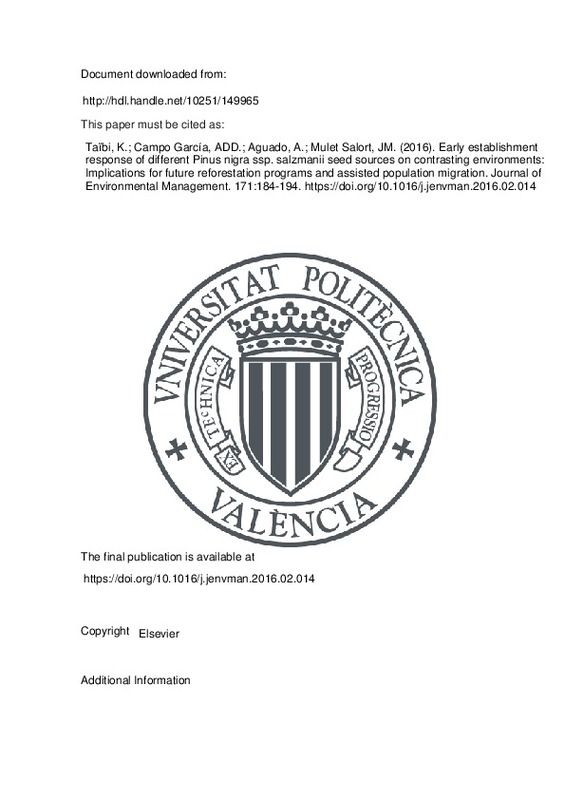JavaScript is disabled for your browser. Some features of this site may not work without it.
Buscar en RiuNet
Listar
Mi cuenta
Estadísticas
Ayuda RiuNet
Admin. UPV
Early establishment response of different Pinus nigra ssp. salzmanii seed sources on contrasting environments: Implications for future reforestation programs and assisted population migration
Mostrar el registro sencillo del ítem
Ficheros en el ítem
| dc.contributor.author | Taïbi, Khaled
|
es_ES |
| dc.contributor.author | Campo García, Antonio Dámaso Del
|
es_ES |
| dc.contributor.author | AGUADO, A.
|
es_ES |
| dc.contributor.author | Mulet Salort, José Miguel
|
es_ES |
| dc.date.accessioned | 2020-09-12T03:35:31Z | |
| dc.date.available | 2020-09-12T03:35:31Z | |
| dc.date.issued | 2016-04-15 | es_ES |
| dc.identifier.issn | 0301-4797 | es_ES |
| dc.identifier.uri | http://hdl.handle.net/10251/149965 | |
| dc.description.abstract | [EN] Forest restoration constitutes an important issue within adaptive environmental management for climate change at global scale. However, effective implementation of these programs can only be achieved by revising current seed transfer guidelines, as they lack inherent spatial and temporal dynamics associated with climate change. In this sense, provenance trials may provide key information on the relative performance of different populations and/or genotypes under changing ecological conditions. This study addresses a methodological approach to evaluate early plantation performance and the consequent phenotypic plasticity and the pattern of the adaptation of different seed sources in contrasting environments. To this end, six seed sources of Salzmann pine were tested at three contrasting trial sites testing a hypothetical assisted population migration. Adaptation at each site was assessed through Joint Regression and Additive Main effect and Multiplication Interaction (AMMI) models. Most of the observed variation was attributed to the environment (above 90% for all traits), even so genotype and genotype by environment interaction (GxE) were significant. Seedlings out-planted under better site conditions did not differ in survival but in height growth. However, on sites with higher constraints, survival differed among seed sources and diameter growth was high. The adaptation analyses (AMMI) indicated that the cold-continental seed source Soria performed as a generalist seed source, whereas Cordilleras Beticas , the southernmost seed source, was more adapted to harsh environments (frost and drought) in terms of survival. The results supported partially the hypothesis that assisted migration of seed sources makes sense within limited transfer distances, and this was reinforced by the GxE results. The present study could be valuable to address adaptive transfer of seedings in ecological restoration and to determine the suitable seed sources for reforestation programs and assisted population migration under climatic changes. The reported results are based on 3 years' data and need to be considered in this context. | es_ES |
| dc.description.sponsorship | This study is a part of the research project: "Application of molecular biology techniques in forest restoration in Mediterranean environments, PAID-05-11" funded by the Universitat Politecnica de Valencia (UPV), program for supporting R&D of new multidisciplinary research lines. The authors are grateful to MeteoCat and Emilio Olid (Meteoclimatic) for the meteorological data and to Jaime Flors and Tragsa for field work and to Dr. Paulo Canas Rodrigues from the Research Center for Mathematics and Applications, Nova University of Lisbon, Portugal, for the deliverance and the guidance of some R codes. The authors also thank the anonymous referees for reviewing the manuscript. | es_ES |
| dc.language | Inglés | es_ES |
| dc.publisher | Elsevier | es_ES |
| dc.relation.ispartof | Journal of Environmental Management | es_ES |
| dc.rights | Reconocimiento - No comercial - Sin obra derivada (by-nc-nd) | es_ES |
| dc.subject | Adaptive silviculture | es_ES |
| dc.subject | Survival | es_ES |
| dc.subject | Growth | es_ES |
| dc.subject | Phenotypic plasticity | es_ES |
| dc.subject | Genotype by environment interaction | es_ES |
| dc.subject | Adaptation analysis | es_ES |
| dc.subject.classification | BIOQUIMICA Y BIOLOGIA MOLECULAR | es_ES |
| dc.subject.classification | TECNOLOGIA DEL MEDIO AMBIENTE | es_ES |
| dc.title | Early establishment response of different Pinus nigra ssp. salzmanii seed sources on contrasting environments: Implications for future reforestation programs and assisted population migration | es_ES |
| dc.type | Artículo | es_ES |
| dc.identifier.doi | 10.1016/j.jenvman.2016.02.014 | es_ES |
| dc.relation.projectID | info:eu-repo/grantAgreement/UPV//PAID-05-11/ | es_ES |
| dc.rights.accessRights | Abierto | es_ES |
| dc.contributor.affiliation | Universitat Politècnica de València. Departamento de Biotecnología - Departament de Biotecnologia | es_ES |
| dc.contributor.affiliation | Universitat Politècnica de València. Departamento de Ingeniería Hidráulica y Medio Ambiente - Departament d'Enginyeria Hidràulica i Medi Ambient | es_ES |
| dc.contributor.affiliation | Universitat Politècnica de València. Instituto Universitario Mixto de Biología Molecular y Celular de Plantas - Institut Universitari Mixt de Biologia Molecular i Cel·lular de Plantes | es_ES |
| dc.description.bibliographicCitation | Taïbi, K.; Campo García, ADD.; Aguado, A.; Mulet Salort, JM. (2016). Early establishment response of different Pinus nigra ssp. salzmanii seed sources on contrasting environments: Implications for future reforestation programs and assisted population migration. Journal of Environmental Management. 171:184-194. https://doi.org/10.1016/j.jenvman.2016.02.014 | es_ES |
| dc.description.accrualMethod | S | es_ES |
| dc.relation.publisherversion | https://doi.org/10.1016/j.jenvman.2016.02.014 | es_ES |
| dc.description.upvformatpinicio | 184 | es_ES |
| dc.description.upvformatpfin | 194 | es_ES |
| dc.type.version | info:eu-repo/semantics/publishedVersion | es_ES |
| dc.description.volume | 171 | es_ES |
| dc.identifier.pmid | 26897555 | es_ES |
| dc.relation.pasarela | S\304058 | es_ES |
| dc.contributor.funder | Universitat Politècnica de València | es_ES |







![[Cerrado]](/themes/UPV/images/candado.png)

